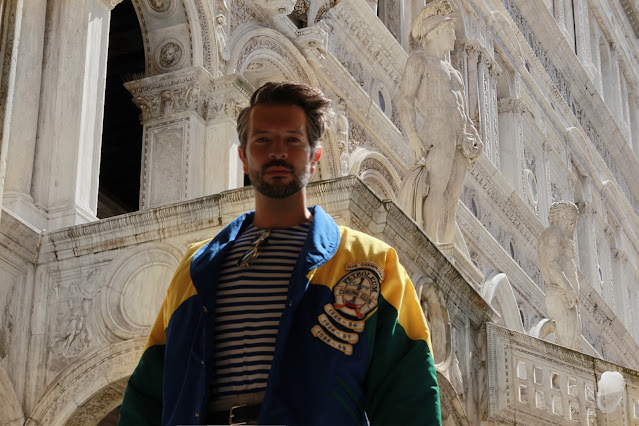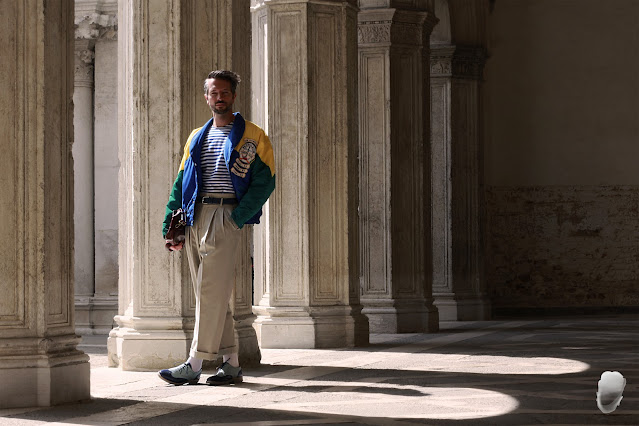If you asked me about one of my
favourite cities for its beauty and authenticity, without a doubt I would have
to say Venice. Many will say the place is overrated, that it smells bad, that
it’s packed with tourists, but this simply indicates they have different
interests when it comes to traveling or perhaps, they missed looking beyond the
obvious, since, here, every square, façade, corner and alley is an ornament on
its own despite the decadence. This historic city, well-known for its
magnificent canals and frequent flooding, has a lot to tell and to offer. We
have already studied its fascinating history at school, in books or
documentaries so I will not get into explaining any of this, but I would like
to share some of the curiosities that have caught my attention during my last
visit.
Venice has more than 170
canals, 3,000 alleys and 400 bridges, all forming a great labyrinth. Additionally,
there are around 350 gondolas and 400 gondoliers in the city of Venice.
Gondolas are one of the most famous symbols of Venice and are known worldwide
for this typical Venetian boat is very old and its existence is a result of a
series of highly complex craft techniques. As you already know, they are the
main method of transportation in Venice together with the ‘vaporettos’
(canal boats) since cars cannot enter the islands. Until recently, Venice
had no female gondolier; it had always been a man's job until 2010 when this started
changing. Becoming a gondolier is very complicated and only 3 or 4 new
gondolier licenses are issued per year.
The art of driving a gondola is a historical Venetian tradition, previously
passed down from father to son, however now it is regulated by a strict
training protocol. In addition, those who apply must have accumulated more than
400 hours of training, completed an apprenticeship course with a gondolier
master, and pass an exam. The gondolas must be painted completely black. This old
law was designed to reduce unfair competition among the city's many gondoliers.
And that's why today, gondoliers decorate the interiors with bright colours,
padded seats, and eye-catching extras to make them stand out from the crowd. Lastly,
one of the most sung songs by the gondolieri in Venice (and typically requested
by tourists) is “Oh, sole mio” which is a song from Naples and not one to be
confused for a local one.
A linguistic fascination I
discovered more about was that the Italian greeting word “ciao” which was born
in Venice. In fact, the word derives from the expression “Sciavo vostro” (“your
slave”) which was used as a form of respectful salutation among the Venetians. On
the same topic, another curious fact is that until 1866 French and German were
spoken widely in the area. It was not until around that time that Venice became
part of Italy Also, the popular cocktail Spritz has got some interesting
history. This alcoholic drink is very typical in Venice and is believed to have
been invented by Austrian soldiers during the Austrian control in Italy. Apparently,
they were finding the local wine too strong, so they decided to add some
sparkling water. The evidence of the origin becomes clear since 'spritzen'
means 'sparkling' in their language.
It's popular that the city is
surrounded by water and in autumn, especially in October and November, the tides
rise, which very often leads to a flooding effect. The rising water phenomenon
is problematic for Venetians, but it is an unusual and exciting experience for
tourists, as it is a unique event. To see Piazza San Marco under water
in an infinity-like pool with boats floating a few meters down is undoubtedly a
moment, which has been immortalised several times in recent years by famous
photographers. However, since 2020 the situation has improved a little thanks
to a new controversial system of levees that control the tides. It’s a fact
that Venice is sinking. It is built on muddy waters and this leading its faith;
due to a combination of natural and human causes, the city is sinking up to 2mm
per year.
For the first time I walked
through Varisco street. One of the narrowest streets in the world. It only
measures 53cm wide and is named after the Varisco family, a group of silk
workers known to the city in the 15th century. Another thing I didn't know was
that the famous Campanile in San Marco Square is an exact replica, since the
original collapsed in 1902 which was built in 1514.
We have all heard of the
popular Venice Carnival. It is the main event in the city, and it is undeniably
an impressive spectacle; fun fact: Napoleon Bonaparte forbade it during the
years of French occupation for fear of conspiracies but beginning of the 20th
century, it went back to being celebrated again. A curious detail of a
different nature is that the first ghetto was created in Venice. It is
surprising to know that it was in Cannaregio that the first Jewish ghetto was
founded. That occurred in 1516 when the Jews of Venice were forced to settle in
the area. Today you can still see its great synagogues and hidden symbolisms
around. Cannaregio is for sure a special neighbourhood!
One about the city’s layout. It
is almost impossible to find an address in Venice. The houses in Venice are
numbered according to the districts, not by specific streets, causing even the
postmen to get confused. The best way to orient yourself is through a monument,
shop, or a famous building. Even though we always see its street crowded, I
have been told that fewer and fewer people live there permanently nowadays. The
population of Venice has been reduced from 120,000 to 60,000 in the last 50
years alome. Maintaining old structures is a pricey weight for many families
and that is the main reason that leads them to leave the city, now dominated by
tourists.
Venice has been the hometown of
quite a few prominent people. Casanova, the one and only, historically known as
a writer and a diplomat but also famous above all as the archetype of the
seductive libertine, of whom 132 love conquests have been counted. Another important
historical person born here, unfortunately much less known, was Elena Lucrezia
Cornaro Piscopia, the first woman to obtain a university degree in the world.
Contrary to what many people think, Marco Polo was not born here but in Corfu,
which at that time was part of the Venetian Republic.
I’ll leave the technicalities
of the grand Architecture of Venice overall to the specialists but bringing up
the bridges again I found several interesting twists about the city’s
connectors. Many believe that one of the most visited Bridge of Sighs
owes its name to the sighs it provokes in bypassers when glared at, due to its indisputable
beauty. False! The sighs were once coming from the prisoners who crossed
through it heading to jail, while they looked at the sky for the last time. On
the bridge topic, the Rialto Bridge, also famous of the city, was a bridge
whose construction aroused very little confidence from the beginning. Gossip had
it that the first stone-bridge in the city would fall, that it was impossible
to raise, in addition to many other demotivating comments such as "it will
only end when I grow another leg" or "if you manage to finish it,
I'll burn alive" etc. And so it happened that when it finally got finished
it was decided to set those “promises” in stone and today you can see a
sculpture of a woman on fire and a man with three legs on the capitals
of the Palazzo dei Camerlenghi, near the bridge. There are several bridges with unusual names, such as the Ponte
delle Tette (bridge of the tits) that used to be frequented by prostitutes
waiting for clients, and the Ponte dei Pugni (bridge of the punches) that was
once transformed into a kind of open-air ring, although here the one who’d lose
would end straight in the water. In 1705, these fights were prohibited due to
their extreme violence. And finally if you want to see a bridge without
railings you must go to the Ponte Chiodo (bridge of nails).
Nothing felt more appropriate
to wear than this sailor-looking, stripy t-shirt in white and bright, blue
tones, quite fit in the body and 3/4 sleeves, slightly rolled-up and tucked in
these flattering, high-waist trousers. Stone colour, straight-cut pleated
bottoms that go beautifully with a blue, leather belt. The matching
brogues came naturally to complete the look. I love the blue contrast but I
also adore the rubber sole that makes the shoe extra light and incredibly
comfortable to wear. Fantastic when as a tourist you don't want to be forced to
choose between comfort and style. The colourful and puffy outwear is my latest acquirement
and one of my favourites too. A vintage, bomber jacket, oversized in vivid colour-block
tones like yellow, green and blue, designed with a look-nowhere-else shawl
lapel around the neck. The sunglasses with rounded lenses and gold rims and
temples are a must and I am combining them with a brown, leather cross-bag
perfect for carrying the absolutely essentials while sightseeing. I could not
help wanting to give yet another sailor element to the look and this navy hat was
the last touch. Far from any regular cups, this eye-catching accessory felt
just right this day, this place and this look.





































Comments
Post a Comment